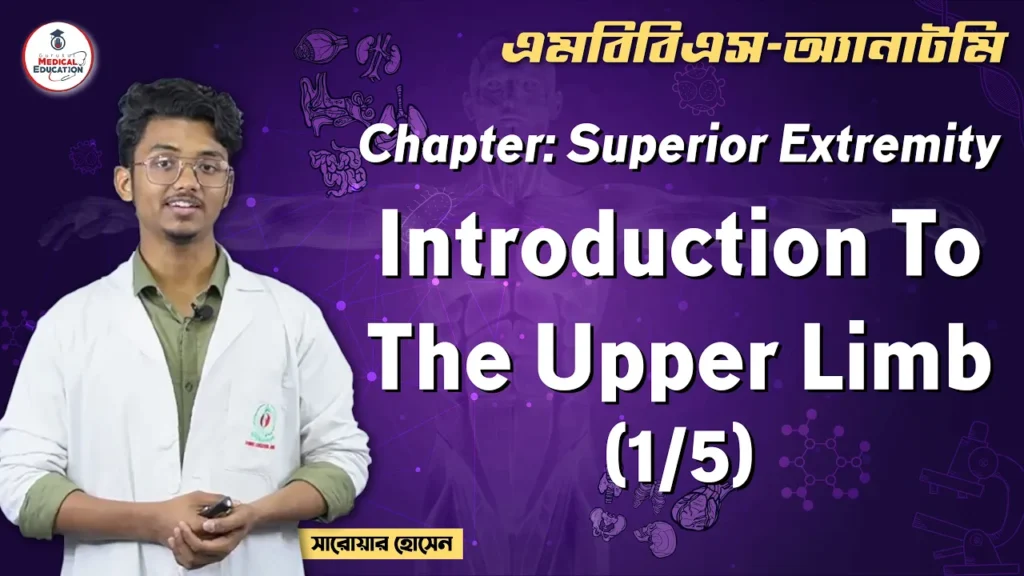Introduction To The Upper Limb আমাদের আজকের আলোচনার বিষয়। “Introduction To The Upper Limb” ক্লাসটি “এমবিবিএস [ MBBS ]” এর “এনাটমি [ Anatomy ]” সাবজেক্ট এর “সুপিরিয়র এক্সট্রিমিটি [ Superior Extremity ]” অধ্যায়ের পাঠ। আজকের ক্লাসে “Comparative anatomy of the limbs, Types of grips, Changes took place in the upper limbs of humans during evolution, Pectoral girdle, Parts and of the upper limb” বিষয়গুলো পড়ানো হয়েছে। ”
Introduction To The Upper Limb
The upper limbs or upper extremities are the forelimbs of an upright-postured tetrapod vertebrate, extending from the scapulae and clavicles down to and including the digits, including all the musculatures and ligaments involved with the shoulder, elbow, wrist and knuckle joints. In humans, each upper limb is divided into the arm, forearm and hand, and is primarily used for climbing, lifting and manipulating objects.
In formal usage, the term “arm” only refers to the structures from the shoulder to the elbow, explicitly excluding the forearm, and thus “upper limb” and “arm” are not synonymous. However, in casual usage, the terms are often used interchangeably. The term “upper arm” is redundant in anatomy, but in informal usage is used to distinguish between the two terms.
In the human body, the muscles of the upper limb can be classified by origin, topography, function, or innervation. While a grouping by innervation reveals embryological and phylogenetic origins, the functional-topographical classification below reflects the similarity in action between muscles (with the exception of the shoulder girdle, where muscles with similar action can vary considerably in their location and orientation.
Musculoskeletal system
Shoulder girdle
The shoulder girdle or pectoral girdle, composed of the clavicle and the scapula, connects the upper limb to the axial skeleton through the sternoclavicular joint (the only joint in the upper limb that directly articulates with the trunk), a ball and socket joint supported by the subclavius muscle which acts as a dynamic ligament. While this muscle prevents dislocation in the joint, strong forces tend to break the clavicle instead.
The acromioclavicular joint, the joint between the acromion process on the scapula and the clavicle, is similarly strengthened by strong ligaments, especially the coracoclavicular ligament which prevents excessive lateral and medial movements.
Between them these two joints allow a wide range of movements for the shoulder girdle, much because of the lack of a bone-to-bone contact between the scapula and the axial skeleton. The pelvic girdle is, in contrast, firmly fixed to the axial skeleton, which increases stability and load-bearing capabilities.
The mobility of the shoulder girdle is supported by a large number of muscles. The most important of these are muscular sheets rather than fusiform or strap-shaped muscles and they thus never act in isolation but with some fibres acting in coordination with fibres in other muscles.
- Muscles
- of shoulder girdle excluding the glenohumeral joint
- Migrated from head
- Trapezius, sternocleidomastoideus, omohyoideus
- Posterior
- Rhomboideus major, rhomboideus minor, levator scapulae
- Anterior
- Subclavius, pectoralis minor, serratus anterior
Shoulder joint
The glenohumeral joint (colloquially called the shoulder joint) is the highly mobile ball and socket joint between the glenoid cavity of the scapula and the head of the humerus. Lacking the passive stabilisation offered by ligaments in other joints, the glenohumeral joint is actively stabilised by the rotator cuff, a group of short muscles stretching from the scapula to the humerus. Little inferior support is available to the joint and dislocation of the shoulder almost exclusively occurs in this direction.
The large muscles acting at this joint perform multiple actions and seemingly simple movements are often the result of composite antagonist and protagonist actions from several muscles. For example, pectoralis major is the most important arm flexor and latissimus dorsi the most important extensor at the glenohumeral joint, but, acting together, these two muscles cancel each other’s action leaving only their combined medial rotation component.
On the other hand, to achieve pure flexion at the joint the deltoid and supraspinatus must cancel the adduction component and the teres minor and infraspinatus the medial rotation component of pectoralis major. Similarly, abduction (moving the arm away from the body) is performed by different muscles at different stages.
The first 10° is performed entirely by the supraspinatus, but beyond that fibres of the much stronger deltoid are in position to take over the work until 90°. To achieve the full 180° range of abduction the arm must be rotated medially and the scapula most be rotated about itself to direct the glenoid cavity upward.
Introduction To The Upper Limb class details:
See also :

